TL;DR
- Differentiates custom vs ready-made CRM, highlighting flexibility, cost, and adoption advantages.
- Step-by-step builds a CRM on Flatlogic with React, Node.js, and PostgreSQL.
- Defines core entities (Users, Leads, Contacts, Companies) and relationships.
- Deploys to cloud and GitHub; REST API and low-code edits enable fast iteration.
Fact Box
- 84% of leading companies report significant benefits after implementing a CRM system.
- This guide uses React frontend, Node.js backend, and PostgreSQL to build a custom CRM on Flatlogic. Source
- Core schema includes Users, Leads, Contacts, and Companies with defined relationships between them. Source
- Flatlogic's generated CRM includes a ready-made REST API for entity access and integration. Source
- A complete CRM can be built and deployed on Flatlogic in tens of minutes.
Imagine the sunny hustle and bustle of LA, California where businesses are booming and customer relationships are crucial to survival in a highly competitive market. At the heart of this, a tried and trusted tool companies rely on is Customer Relationship Management (CRM) systems. From tracking customer interactions to crunching valuable data for marketing teams, a CRM system is a game-changer for businesses.
How to build a CRM system from scratch? What are the differences between custom CRM and out-of-the-box CRM systems? How does a CRM system enhance customer relationships? What are the benefits of implementing a CRM system? How to do that if you don’t know a single programming command? Well, my friend, don’t worry, because you’ve just hit the sweet spot!
Over the years, forward-thinking companies have used CRM technology to improve customer relationships, support systems, and more. An astounding 84% of leading companies have experienced the significant benefits of implementing a CRM system. Imagine world-class customer service, skyrocketing customer retention rates, skyrocketing customer engagement, and ultra-fast sales cycles. Makes you want to jump on the bandwagon, doesn’t it?
Lucky for you, this comprehensive guide is just what you need. I’ll serve as your trusty guide, helping you navigate the challenging yet exhilarating journey of creating a CRM system using the magic of the Flatlogic platform. We’ll dive right into the application-building process from the ground up. I’ll meticulously guide you through the journey of manifesting your exclusive CRM application.
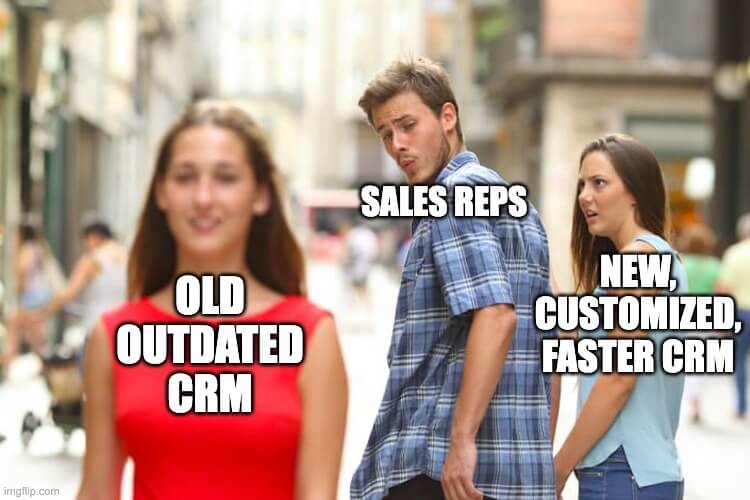
What is a Custom CRM System?
A custom CRM (Customer Relationship Management) system is software that helps businesses manage customer data and interactions with customers, partners, and other stakeholders. Giving businesses a thorough perspective of their customers is a potent instrument that aids in process simplification, customer relationship improvement, and revenue growth. Features like contact management, sales tracking, lead management, customer support, and more are available with bespoke CRM systems. For the best customer relationship management systems, they are often tailored to each business’s unique demands. 
A ready-made CRM system is a CRM solution that has already been designed and is instantly available for purchase and use. The most frequently used features and capabilities are pre-configured in these CRM systems. In comparison with traditional systems created from scratch, they often only need little customization from the user and can offer a rapid return on investment. Ready-made CRM systems are often offered as subscription-based, cloud-based services.
Custom CRM System vs. Ready-Made CRM System
| Custom CRM System | Ready-Made CRM System |
| Flexible and Tailored to Your Specific Needs | Pre-Packaged Solution |
| Cost Transparency, Lower Cost Over Time | High Upfront Cost |
| In-house IT Staff or Contractors for Support | Paid Support / Updates |
| Easy Upgrade to New Requirements | Conversion of Data May be Necessary |
| Increases Business Efficiency | Potentially Long Implementation Cycle |
| Adoption and Integration Process Shorter | Security Unlikely to be Tailored to Your Business |
| Improved Customer Relationship Management | Difficult to Adapt to Changing Business Processes |
6 Benefits of using a Custom CRM System?
Benefit #1 Enhancing Relationships with Existing Customers
One of your business’s most valuable resources is active customers. They guarantee the business’s financial stability. Furthermore, they have the potential to become loyal customers and brand ambassadors. Using custom CRM software, for this reason, may be invaluable, as it allows your company to obtain a better understanding of these clients’ requirements, preferences, and patterns of activity.
Benefit #2 Improved Integration of Marketing and Sales Departments
Your teams in sales and marketing must work together for the best results. The only way they can accomplish this is if they have a platform that gives them easy access to all the client data they require. Through the establishment of a CRM, marketers may improve lead nurturing, provide communications catered to the client’s interests, and more.
Benefit #3 Giving Sales Leaders More Authority
Designing custom CRM software is a great way to give more control and power to the sales leader. With the data he can access, the resources used for efficient management are reduced; allowing him to get more done. Tracking and monitoring results are important to an entrepreneur to maintain complete control over the operations; making custom CRM an effective solution.
Benefit #4 Practical Storage
A comprehensive custom CRM system is the solution to ensure quality standards and streamlined processes. All information is stored in one place, allowing the entire team to have access to it and make updates in real time. This is the best way to manage data efficiently and maintain high-quality standards.
Benefit #5 Focusing on Customers and Streamlining Sales Processes
A custom CRM system keeps the customer in mind, allowing you to concentrate on strategic planning. Automation eliminates the need for tedious tasks and allows more time to develop streamlined sales processes and solid strategies. The data from a dedicated CRM helps marketing and sales be highly effective; you can identify problems quickly and identify resources where needed.
Benefit #6 Tracking Results and Managing Data
An efficient CRM tool allows viewing data in one convenient place. Through increased real-time reporting, your decisions become more urgent and effective. This enables you to quickly identify any issues that may arise, and then provide effective, data-based solutions.
How to Build a Custom CRM System Using Flatlogic Platform
Step 1: Creating a Web Application
To begin, visit the Flatlogic website and click on the “Create a Web Application” button. Enter the name of your application, in this case, “Custom CRM”. Select the frontend technology stack, choosing React. For the backend, opt for Node.js with PostgreSQL as the database. You can also pick any other technology stack you prefer. Proceed to the next step.
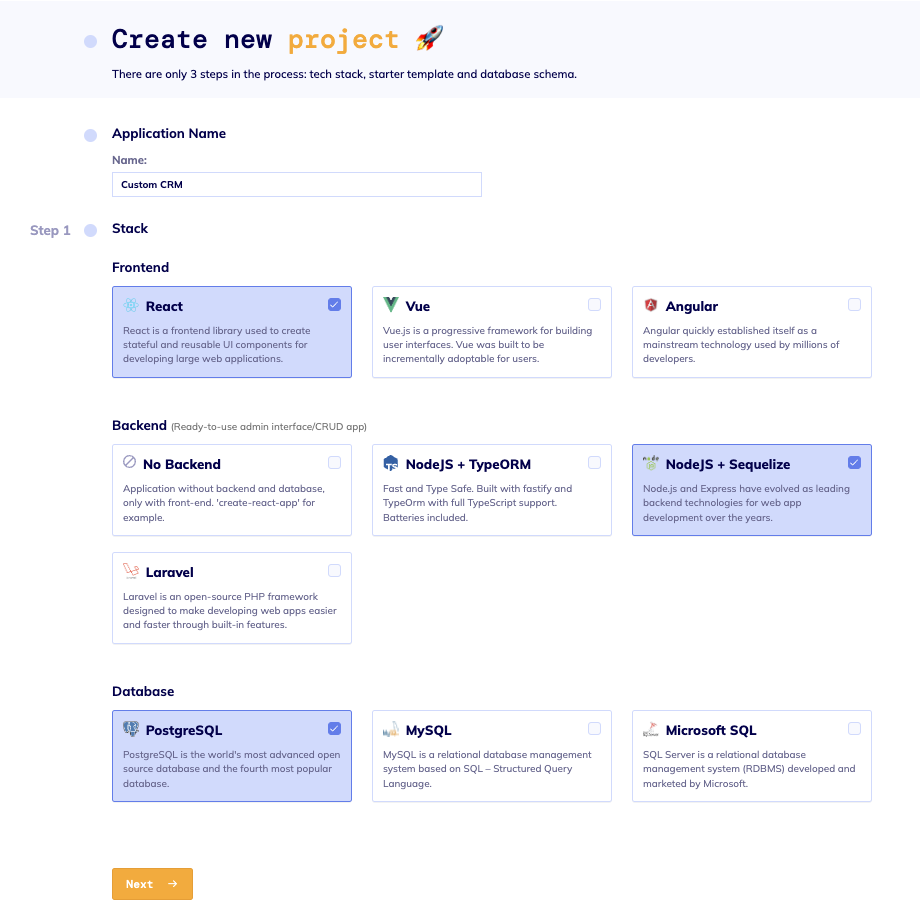
Step 2: Selecting a Template or Starter Kit
At this stage, you can choose a template or starter kit for your CRM application. Let’s choose Material UI.
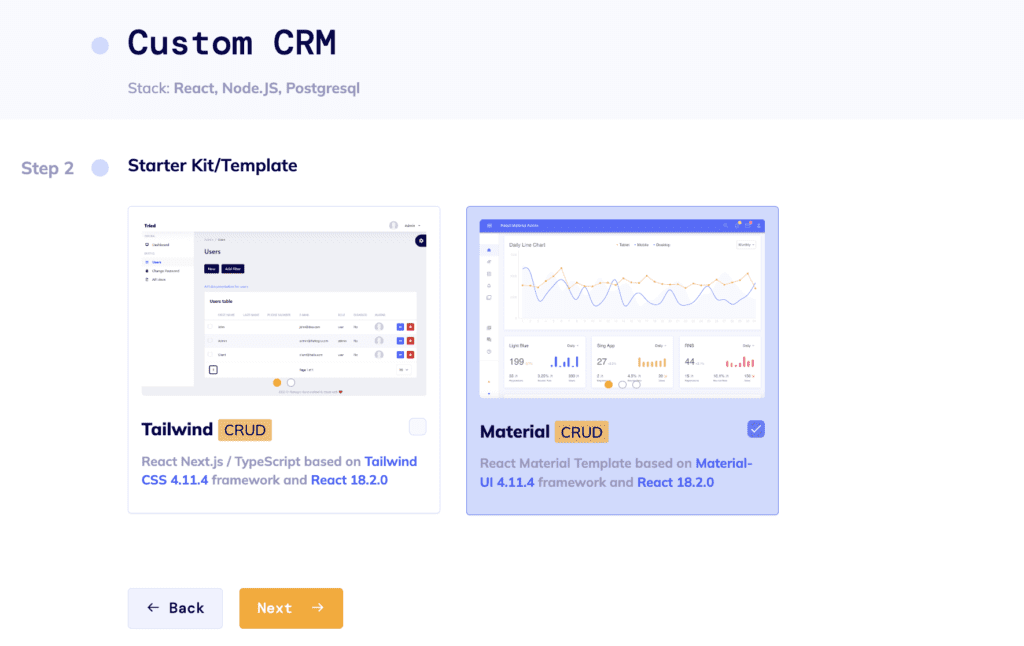
Step 3: Designing the Database Schema
Now, let’s dive into the most crucial step: defining the database schema and the relationships between entities in the application. We will define four entities: Users, Leads, Contacts, and Companies.
- Users: Represents the users of the application, with fields for name, email, and password.
- Leads: Tracks potential customers, with fields for status and date. Leads are associated with Contacts and Users.
- Contacts: Stores contact information, including name and email. Contacts are associated with Companies.
- Companies: Represents the companies associated with contacts, with fields for name and industry.
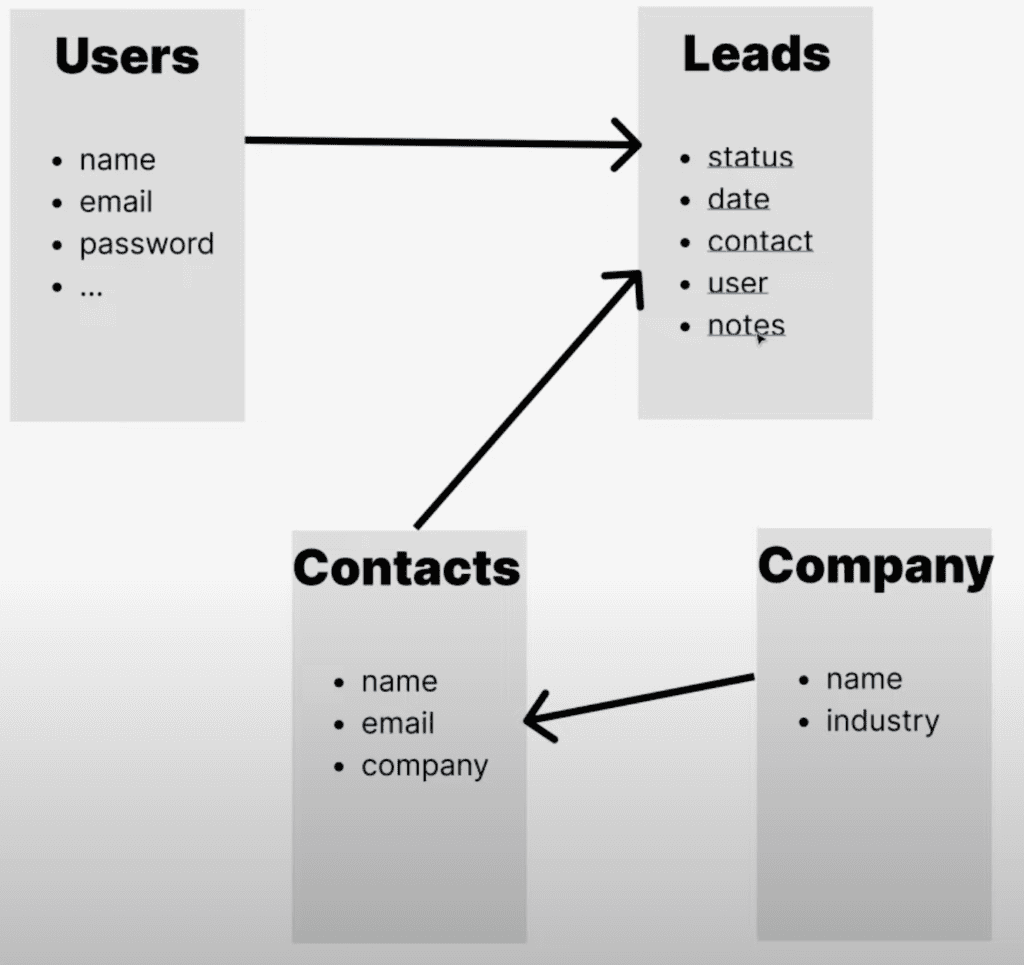
This is a so-called “Entity-relationship model” that is used always at the system’s design phase of the SDLC. It is important to understand and define the relationships between these entities, as they form the foundation of the CRM system. For example, leads are assigned to users, contacts are linked to leads, and contacts belong to companies. Leads have the following properties: status, date, contact, user, and notes. Contacts: name, email, company. Company: name, industry.
Step 4: Working with Schema Editor
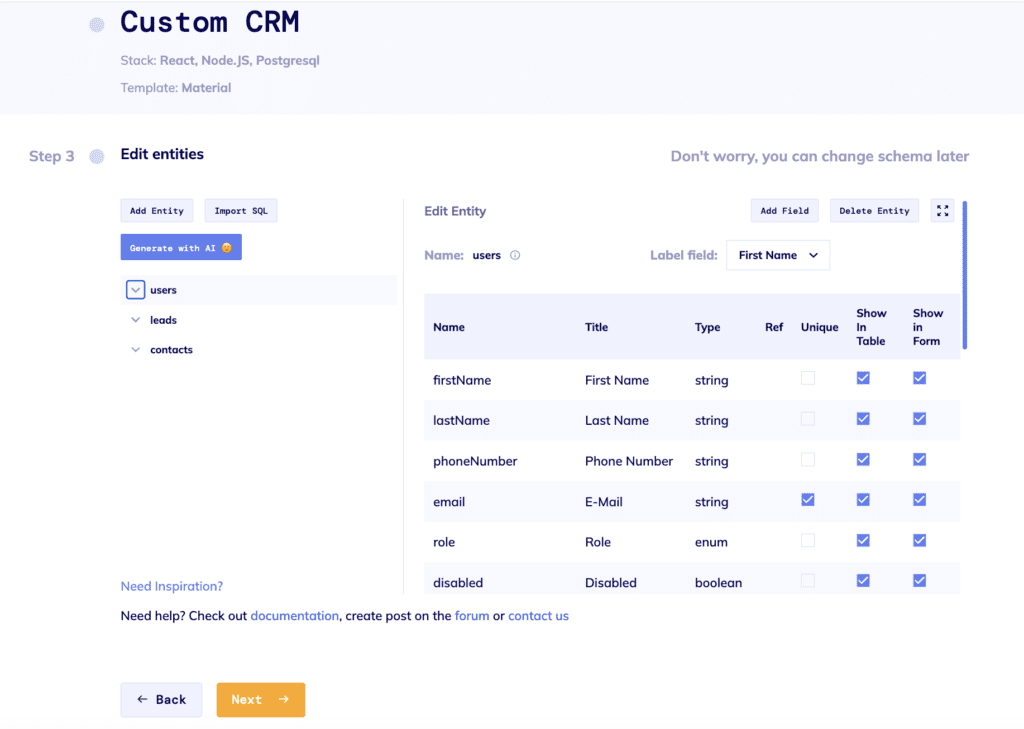
In the Flatlogic platform, you can easily translate the visual representation of the schema into code. Let’s add the entities, fields, and relationships, ensuring the correct data types and associations. Once completed, the schema is saved. Click next to proceed to the next step.
Step 5: Pushing Code to GitHub
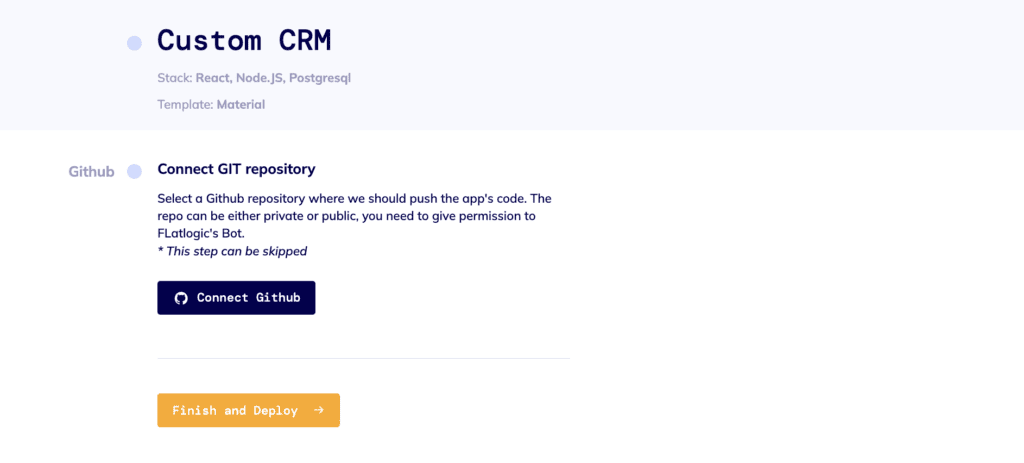
With the application’s code ready, it’s time to push it to a GitHub repository. Flatlogic provides seamless integration with GitHub. Connect the application to a repository named “custom CRM” and initiate the code push. You may skip this step and push the code later.
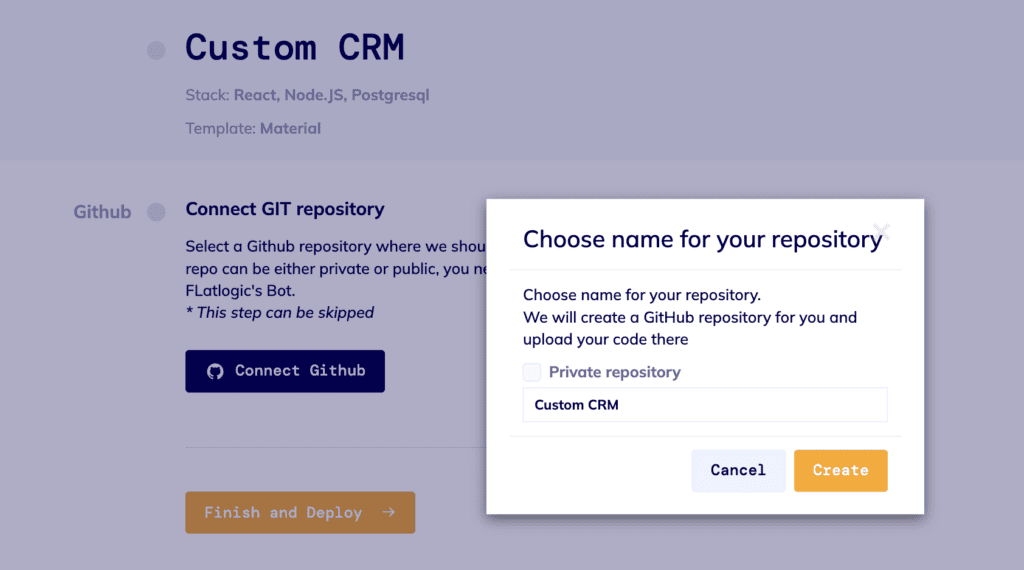
Step 6: Publishing to the Cloud

After pushing the code, the application can be published to the cloud. Click on the “Finish and Deploy” button, and the platform handles the deployment process. The application undergoes building and deployment steps, which may take a few minutes to complete.
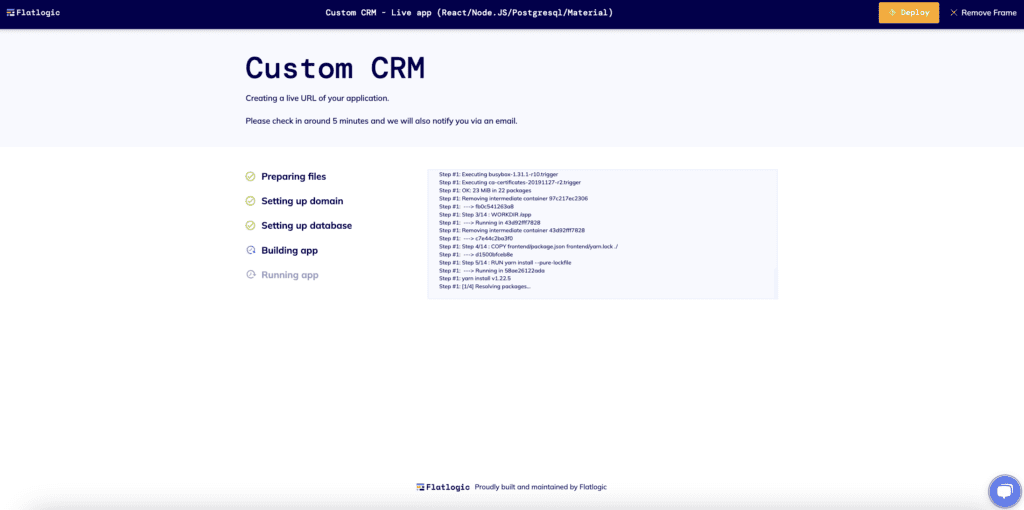
Step 7: Browsing and Managing Entities
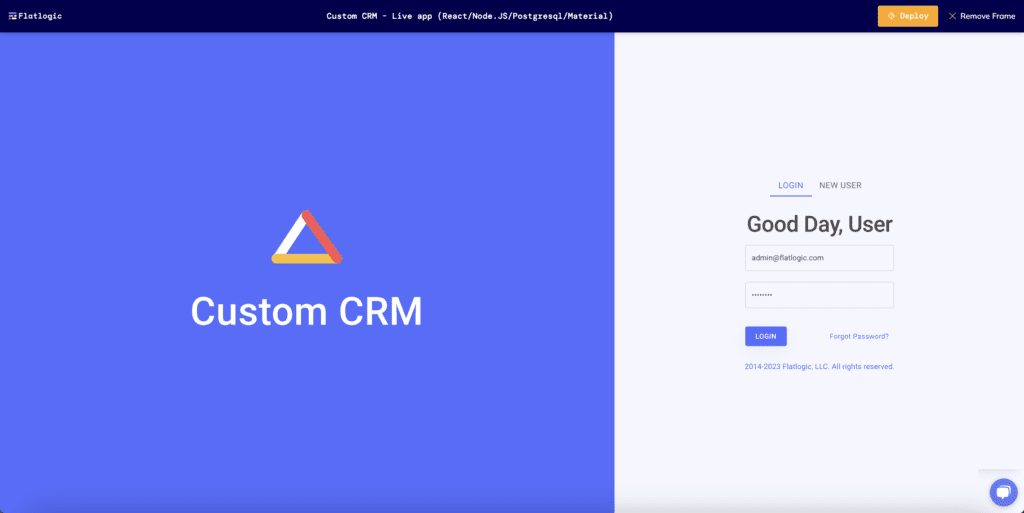
Once the deployment is finished, the application is live and accessible online. You may copy the link and share it with your friends.
Login to the CRM application and browse and manage contacts, leads, and companies. You may create sample contacts and leads, assign them to users, and add relevant information. The application allows sorting, editing, and deleting entities, providing a comprehensive CRM experience.
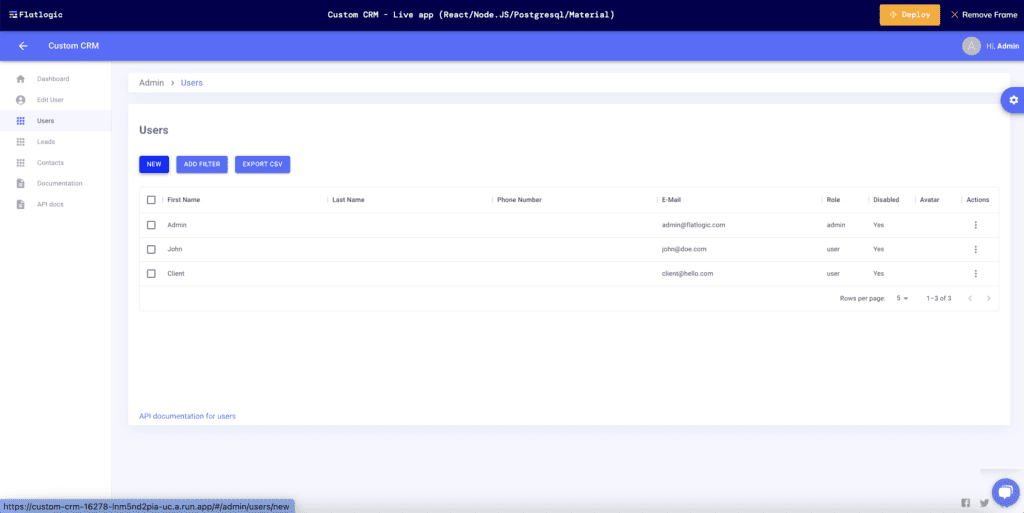
Step 8: Exploring the REST API
Flatlogic’s CRM application also includes a ready-made REST API, enabling developers to interact with the entities programmatically. This feature enhances the flexibility and extensibility of the CRM system, allowing integration with other systems or building custom functionalities.
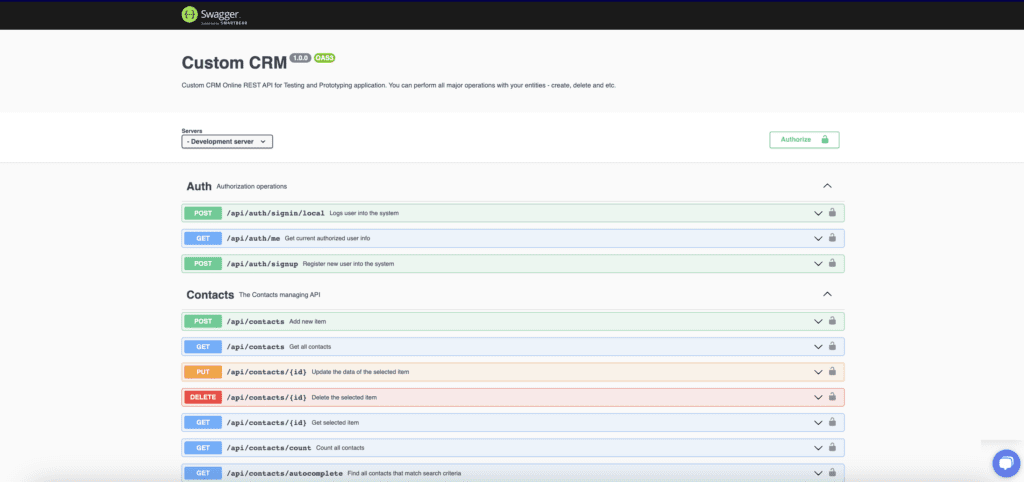
Step 9: Setting Up the Project
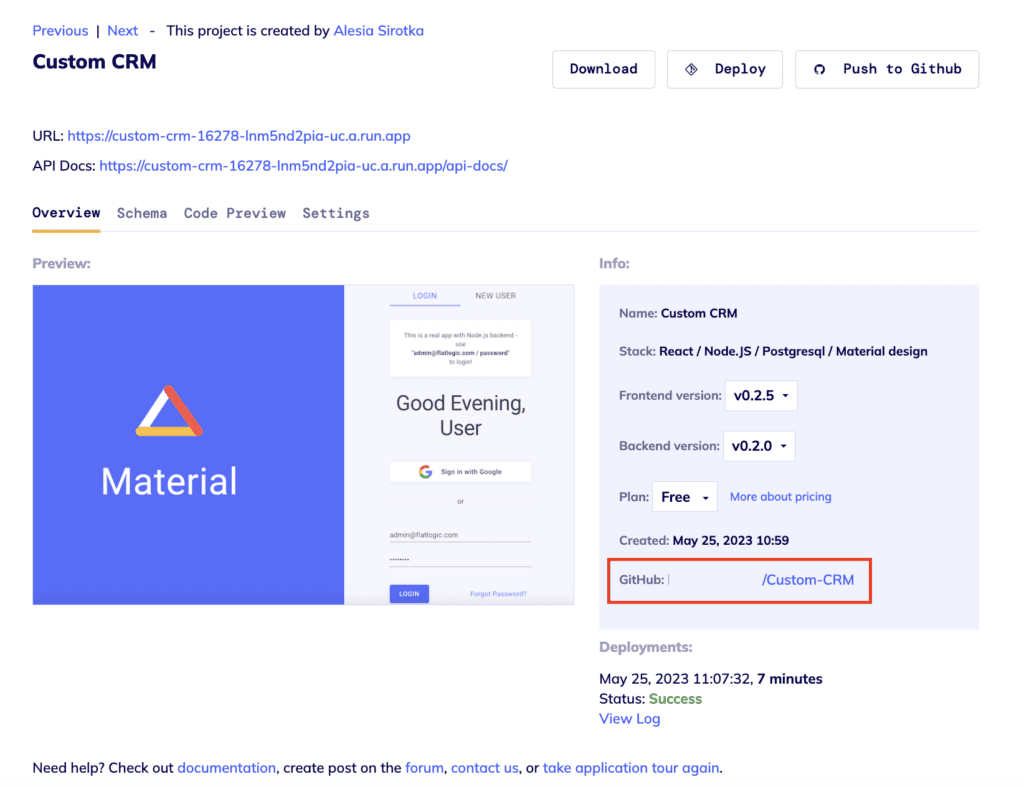
To launch the project locally, first, navigate to GitHub and clone the repository. The project includes backend, frontend, and Docker files.
Inside the repository, the README file provides instructions on how to set up the project both with and without Docker. Follow the instructions to set up the database, run the backend code, and then run the frontend code to launch the project.
Step 10: Running Locally
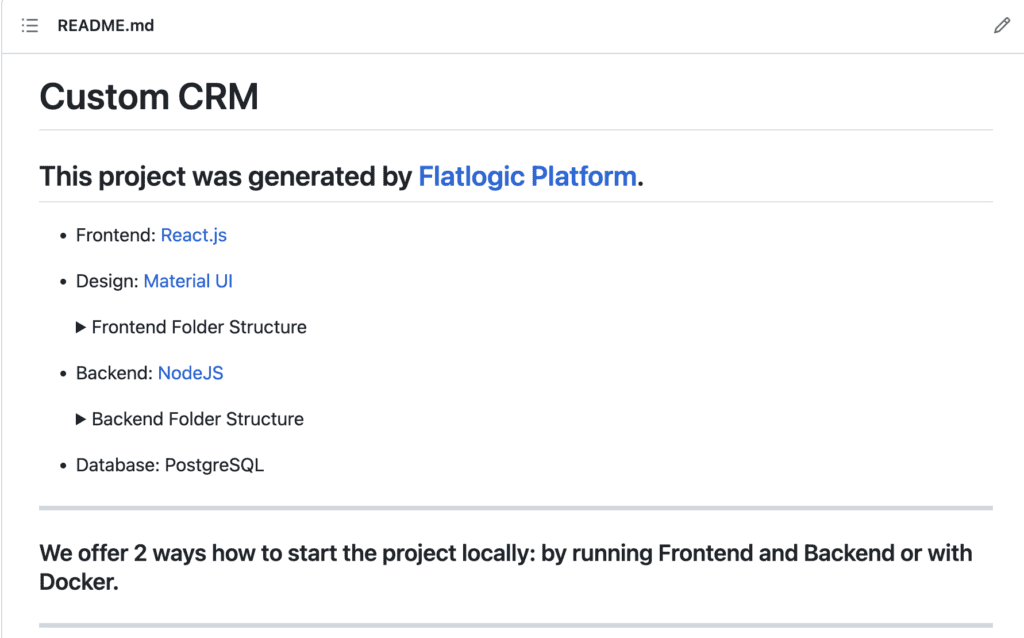
To set up both the backend and frontend for local use start by navigating to the backend folder in the terminal and running yarn to launch it.
Then, set up a PostgreSQL server and create a database using the command, `yarn db create`. After the database is created, run migrations to build the necessary structure.
Moving onto the frontend, change the directory to the frontend folder, and use yarn install to install the required dependencies. When the installation is finished, launch the frontend using `yarn start`, and open the application in the browser at localhost. Finally, log in and verify that both the backend and frontend are working properly.
Step 11: Working with the Code
Just as an example of working with the code, let’s change the type and color of the button “add filter” to the
color=`secondary` variant=`outlined`.

To modify the code locally find the file that corresponds to a given button (frontend→src→pages→CRUD→Contacts→table→ContactsTable.js), alter its appearance, and watch as the code recompiles.

This is how you experience the advantages of low-code development while also having the freedom to modify and customize the code as desired.

Once you’re satisfied with your changes, push them to GitHub by adding the changed files, committing the changes, and pushing them to the repository.

Step 12: Adding Another Entity
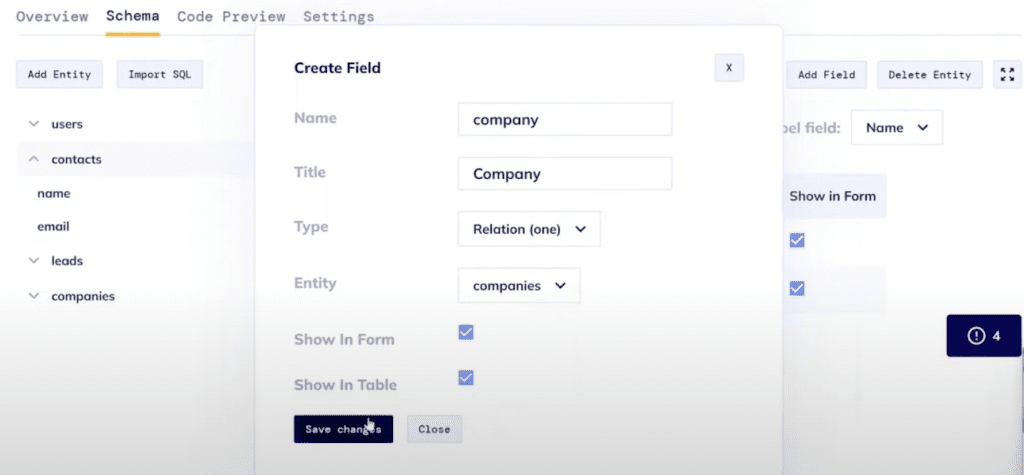
To add the “company” entity that was previously put off go to the schema tab, update the contact entity, and incorporate the company reference. Additionally, forms a relationship between contacts and companies.
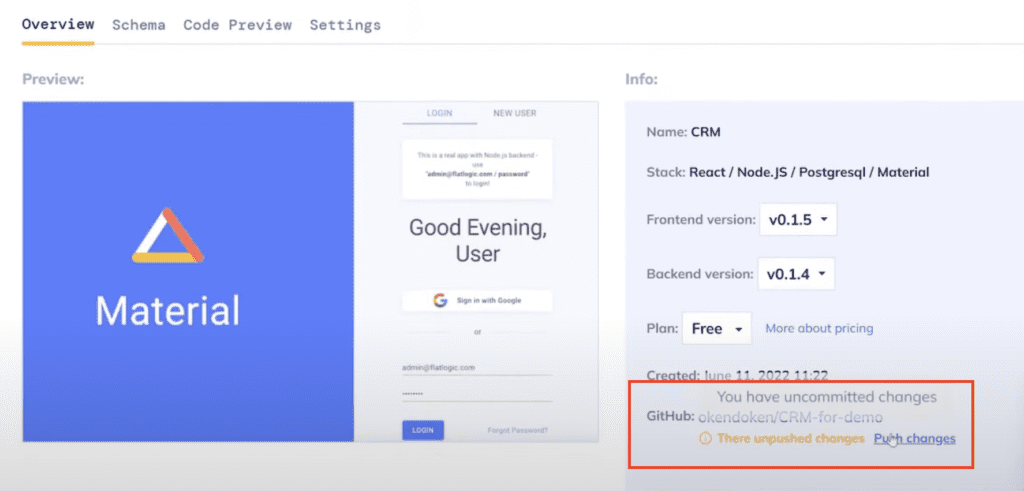
Save the changes and push them to the repository. This will create a pull request to merge them into the master branch. Handle any conflicts that arise and then merge the pull request. Here is the documentation for your reference: https://flatlogic.com/documentation/how-to-work-with-github
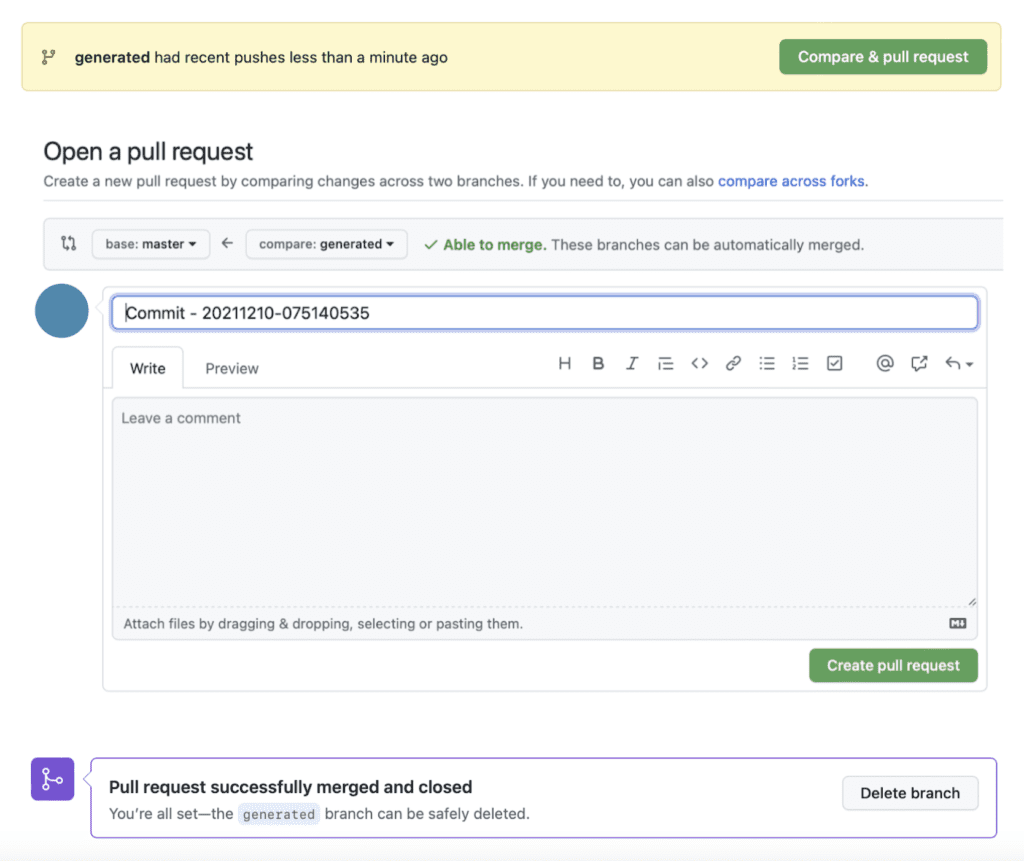
Step 13: Pulling Updates to the Local Machine
To ensure all changes are successfully applied, run ‘git pull’ from the repository to the local machine. Afterward, restart the backend and run migrations. Once that is done, verify the changes in the local application, then create new companies and associate contacts with each one.
Step 14: Deploying Updates to the Cloud

By clicking the deploy button, the changes from the master branch, as well as the modifications made locally and the ones generated by the platform, are updated in the production environment of the application. After the deployment, observe the changes reflected in the live CRM system, such as the addition of companies and the capability to filter data.
With Flatlogic’s AI-powered Business AI App Generator, you can create business apps in minutes.
Below is a list of our solutions:
- Enterprise CRM
- CRM for Non-Profit
- CRM for Financial Advisors
- CRM for Real Estate Agents
- Accounting CRM
- E-commerce CRM
- CRM for Retail
- CRM for Manufacturing
- CRM for Small Business
- CRM for Recruiting
- CRM for Fundraising
- CRM for Startups
- CRM for Sales
- Open Source CRM
Conclusion
So here we are have built a complete CRM web application in tens of minutes. This app is equipped with all the essential features of basic CRM, plus a few additional features to ensure scalability and increased efficiency. What’s even more amazing is that you can easily extend the app to suit your company’s individual needs. With all these features, this is just the perfect solution for simplifying your customer relationship management tasks.